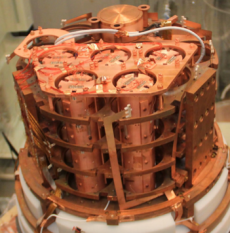Searching for Evidence of a ‘Neutrinoless’ Particle Process
August 21, 2020

The CUPID-Mo detector is installed in the Edelweiss cryostat at Modane Underground Laboratory (LSM) in France. (Credit: CUPID-Mo collaboration)
Science Achievement
Nuclear physicists at Berkeley Lab played a leading role in analyzing data for a demonstration that achieved record experimental precision using a specialized detector material. The data analysis component of this ground-breaking research was conducted entirely at NERSC.
Significance and Impact
The CUPID-Mo experiment is among a field of experiments using a variety of approaches to detect a theorized particle process, called neutrinoless double-beta decay, that could revise our understanding of ghostly particles called neutrinos, and of their role in the evolution of the universe. Preliminary results from CUPID-Mo, based on analysis of data collected from March 2019 to April 2020, set a new world-leading limit for the neutrinoless double-beta decay process in an isotope of molybdenum known as Mo-100 (<1.4 per 14x1023 years!)
Research Details
- All of the data from the CUPID-Mo experiment – the CUPID acronym stands for CUORE Upgrade with Particle IDentification, and “Mo” is for the molybdenum contained in the detector crystal – is transmitted from the Modane Underground Laboratory in France to the Cori supercomputer at NERSC.
- The availability and reliability of Cori during the work-from-home restrictions around the world were key to preparing the results in time for the Neutrino2020 conference in June 2020.
- Benjamin Schmidt, a postdoctoral researcher in Berkeley Lab’s Nuclear Science Division, led the overall data analysis effort for the CUPID-Mo result.
Related Links
T. O’Donnell, Neutrino 2020 Conference, 10.5281/zenodo.3959650
About NERSC and Berkeley Lab
The National Energy Research Scientific Computing Center (NERSC) is a U.S. Department of Energy Office of Science User Facility that serves as the primary high performance computing center for scientific research sponsored by the Office of Science. Located at Lawrence Berkeley National Laboratory, NERSC serves almost 10,000 scientists at national laboratories and universities researching a wide range of problems in climate, fusion energy, materials science, physics, chemistry, computational biology, and other disciplines. Berkeley Lab is a DOE national laboratory located in Berkeley, California. It conducts unclassified scientific research and is managed by the University of California for the U.S. Department of Energy. »Learn more about computing sciences at Berkeley Lab.







